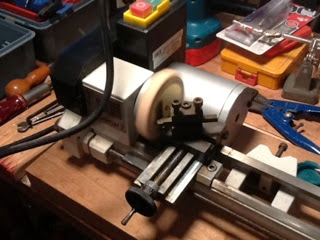Plan B worked well. The item displayed above is made from a brass disk I turned on the lathe, a 1/4" brass washer bored out to 9/32", a 9/32" brass tube, and the top sawn off the Lee Valley small brass knob.
Originally my plan was to solder these together, but I chickened out and used super glue after an early version looked a bit ham fisted:
If I painted the disk black, like the original Remington supplied, I could have used the soldered one, but I wanted to have all the brass showing.
Compare this with the finished pair that I super glued together:
In position on the typewriter below is one of these brass spool covers along with the plastic spool cover held on with transparent plastic tubing together on the machine.
The plastic one and the brass one each do exactly the same job as the original would have done, but I think the brass version looks better with the elegant Art Deco style of the machine.
By shear luck, as I hadn't planned it, the carriage return lever clears the top of the left hand spool cover!
Part 1 Part 2 Part 3




















